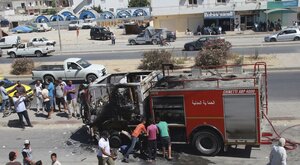Arab Spring's second revolution
Tunisia, home to the Arab world's first successful uprising against a dictator, erupted this week with a battle between radical Islamists and the moderate Islamic party that dominates government. A second revolution, one within Islam that can reconcile it with democracy, will again help the Middle East.

People look at a fire truck, which was set on fire by a group of Salafi protesters during overnight riots in Tunis June 12. Thousands of Salafi Islamists, angered by an art exhibition they say insults Muslims, rampaged through parts of Tunis, raising religious tensions in the birthplace of the Arab Spring and piling pressure on the moderate Islamist government.
REUTERS
The Arab revolution for democracy that began last year in Tunisia has now spawned a second revolution. And once again Tunisia is at the epicenter, with recent protests marking its emergence.
The initial Arab struggle remains one of democracy against secular dictators like Bashar al-Assad in Syria. But in Tunisia, which now has a democracy, a new battle has opened up. It pits the Islamic party Al Nahda that dominates a secular government against ultraconservative Islamist groups – Salafists.
Many Salafists regard ideas like individual rights and religious pluralism as Western imports. They also want liberties according to their interpretation of Islam.
This theological clash between moderate and radical versions of Islam erupted June 10 when Salafists attacked an art exhibition in a suburb of Tunis. The exhibit included a painting with the word “Allah” spelled with insects. Street riots led to an attack on a courthouse, forcing a police crackdown and leaving one person dead, more than 700 injured, and some 160 arrested.
It was the worst unrest since the January 2011 ouster of strongman Zine el-Abidine Ben Ali. The government imposed a night curfew this week in many parts of the country.
For Al Nahda (The Awakening), which rules in a coalition with minority secular parties, this challenge by hard-line Muslims was also a challenge to its commitment to democratic ideals – especially its hope that Islam and democracy can be compatible.
The party rejects using sharia law as the basis for legislation. Yet in one official reaction to the violence, the culture minister shut down the art exhibition. And he seemed to justify the protests because of the artwork’s apparent provocation to Islam.
In addition, the leader of Al Qaeda, Ayman al-Zawahiri, jumped into this struggle, saying from afar that Al Nahda has betrayed the religion.
But the government also barred one Salafist leader from preaching after he called for the killing of the artist. Such action signals that the government wants Salafists to operate within the rules of democracy.
Tunisia’s ruling coalition of secular-Islamic parties is a model for other Arab nations. But now it must also work out an internal debate within Islam, one that centers on whether organized religion should define government or whether government should reflect the will of both the faithful and nonfaithful through democratic principles.
A fear of secular democracy by Islamists can be as pronounced as the fear of radical Islam by secular rulers. Those fears are now playing out in Egypt, where ruling generals are suppressing the Muslim Brotherhood. And the Brotherhood is protesting.
Tunisia is helping break down such fears, not only through its secular-Islamic coalition but in the struggle between Al Nahda and the Salafists. As long as both sides don’t resort to violence and undemocratic tactics, Tunisia’s second revolution could serve the Middle East, just as its first revolution has.

